
Antarctic meteorite (HUT 18036) partially in the ice, in contrast to most samples that are collected while lying on the surface. Meteorite collected by the Lost Meteorites of Antarctica project. Credit: Katherine Joy, The University of Manchester, The Lost Meteorites of Antarctica project.
Antarctica harbors numerous large meteorite concentrations at its surface, and as such, the icy continent contains an unparalleled wealth of information on our Solar System, enabling us to understand, for example, the emergence of life on Earth, and how the Moon was formed.
A study carried out by scientists from the Université Libre de Bruxelles, ETH Zurich, WSL Birmensdorf, and Vrije Universiteit Brussel highlights a rapid disappearance of meteorites due to global warming, a loss with far-reaching consequences for our understanding and knowledge of extraterrestrial life.
Using artificial intelligence to combine satellite observations of the continent with climate model projections, the scientists calculate that for every tenth of a degree of increase in global air temperature, 5,100 to 12,200 meteorites are lost from the surface of the ice sheet. By 2050, about one quarter of meteorites will be lost, and this can rise to three-quarters by the end of the century, depending on future greenhouse gas emissions.
Mechanism of Meteorite Loss
Veronica Tollenaar, PhD researcher (FNRS) at the Laboratoire de Glaciologie (GLACIOL), Faculty of Science – ULB, who co-led the study explains that “even when temperatures of the ice are well below zero, the dark meteorites warm so much in the sun that they can melt the ice directly under the meteorite. Through this process, the warm meteorite creates a local depression in the ice and over time fully disappears under the surface. As atmospheric temperatures increase, the surface temperature of the ice increases, intensifying this process, since less heat from meteorites is required to locally melt the ice.”
To date, it is estimated that at least 300,000 meteorites remain at the surface of the Antarctic ice sheet. The study reveals that due to the currently ongoing warming, each year about 5,000 meteorites are lost, outpacing the pace at which Antarctic meteorites are collected by a factor five.
Harry Zekollari, Department of Water and Climate (VUB) and Laboratoire de Glaciologie (ULB) who co-led the study urges the need for a major international effort: “To secure this invaluable extraterrestrial material, we need to intensify and coordinate the recovery of Antarctic meteorites before we lose them to climate change. In similar efforts as collecting ice cores from vanishing glaciers or sampling coral reefs before they bleach, our study identifies the loss of meteorites as an unexpected impact of climate change upon which we need to act.”









The magic words “artificial intelligence” and “climate models” are used to impart an air of authority to their claim. No one has much to say about why some areas are enriched in meteorites while others aren’t. (Albeit, the journal article does explain it: DOI: 10.1038/s41558-024-01954-y ) What is happening is that most areas are just getting buried ever deeper as the snow accumulates and turns to ice. However, in some areas, the ice is diverted upwards towards the surface. However, that surface is being lowered by local melting in the Summer, and much more drastically by winds sublimating the ice sheet in Winter. It is the act of removing the surface ice, while allowing the meteorites to sink away from sunlight, that is responsible for the meteorites becoming concentrated. Without that, these unusual areas would be no more enriched than the the ‘barren’ areas. Actually, the ‘barren’ areas are the normal situation, and it is the the unappreciated effects of melting and sublimation that are responsible for concentrating the meteorites. The surface exposures of the meteorites are renewed annually. The problem is to find them before they sink back into the ice to a depth where the sun doesn’t cause Summer melting. However, they will come back! They aren’t actually lost to science! I think that their conceptual model is wrong. Accelerated melting should increase the concentration just below the surface where the sun doesn’t reach.
If they want to increase their productivity, I would suggest that the researchers at least use a high-quality metal detector, or spend some money to build a detector that takes advantage of the very high dielectric constant of ice compared to silicate minerals. It will give them something to do when it isn’t field season.
Incidentally, posting similar articles two days apart doesn’t make them any more credible.
In a related article (Evatt, et al., 2016) that is a reference, they say, “We show that meteorites with a high-enough thermal conductivity (for example, iron meteorites) can sink at a rate sufficient to offset the total annual upward ice transport, which may therefore permanently trap them below the ice surface and explain their absence from collection data.”
Then why do ANY of the iron meteorites make it to the surface if they start to melt their surrounding ice well before they reach the surface?
Incidentally, from personal observations working in the ice tunnel at Camp Tuto (Greenland), it appears that once ice begins to shear up over an obstruction, it continues on that path for a considerable distance, even creating an rock-armored surface at the terminus, for which the name “shear moraine” was coined by a CRREL glaciologist. (You probably won’t find it in a text book.) Meanwhile, the ice down-slope from the obstruction may be stagnant (little or no forward motion). Therefore, assumptions about the mechanics of ice flow that the authors say will be responsible for losing meteorites in the future, may be false. That is, the ice does not faithfully follow the topography of the bedrock. (See their illustration in the actual article.)